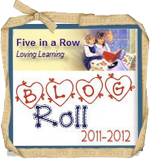Have you read this book? Its such a fun story based on true events of childhood imaginations and delights with friends that span years. Its part of our Five in a Row fun and I'm enjoying it as much now as I did the first time we read it.


It was my turn to teach co-op this time and having taught it before, it was easy to use my notes to tweak it a bit and plan some fun. We started with a devotion. Then on to a lesson about colors of the Southwest. I used some paint chips for this lesson.
They took the colors and tried to match the paint chips to the colors in the book in order to identify the ones that were prominent in the story.
They enjoyed this and then moved to matching other colors too.
We started by learning about simple machines and what they are.
I had gathered a box full of a variety of items. They took turns pulling out an item and then trying to identify what type of simple machine it was.
I used this poster to keep the definitions in front of them. I also used this to help explain the machines.
This is our final assortment of items grouped by type of machine.
A worksheet about simple machines.
Now it was time to test what they had learned. I found several great books at the library which I used for ideas on experiments. (See photo above). I primarily used Simple Machines by Anita Yasuda.
The first experiment was on levers and looking at the distribution of books on one end to see how it affected the lever.
We also did a chopstick challenge as this is a lever too. I counted out the sizes and numbers of pompons and then just had them see who could pick them all up (one at a time) and put them in their cup.
Inclined Plane. Does using this really help with the work load? We measured and tested to find out. First they measured the pull on a rubber band holding a sock of marbles when lifting straight up.
Next we lifted the marbles to the same height by pulling it along the inclined plane. Again, the pull on the rubber band was measured to see which used a greater amount of force.
Wheel and axle. We tested moving something using rollers. The early Egyptians used something like this while building the pyramids.
We also tested out the roller on playdoh and compared it to the force of just pushing on the dough.
Screw. This contraption was made for my older children to measure the movement of water. The water in the bowl was dyed red. There is a tube wrapped around the can. The kids took turns twisting the tube into the water like a screw. This caused the water to rise in the tube. Can you see the red water at the bottom side of the tube?
Wedge. We tested out pushing a wedge of carrot into an apple versus just pushing a carrot that was not cut into it. I think my apple was too firm as both were difficult.
We also looked at the difference in using a sharp metal needle (wedge) and blunt piece of metal. It was definitely easier to sew with the wedge!
Pulley. For the last experiment, they made their own pulley.
They had to improvise to get it to work.
After all of that work, it was time to head outside. We had siblings and a neighbor join us for this part.
Time to make our own Roxaboxen. We headed to the back yard and they began to clear spaces.
We had random materials around that could be used for adding to their sites.
One of the items in the story told about 2 children that sold ice cream. All that you could eat. We had to add that in.
And the currency of our Roxaboxen was rocks.
They all liked this part.
Some (or most) took advantage of the ability to have more than one!
Happy faces. :-)
We also enjoyed cooking our meal to end our time with Roxaboxen. Daniel is really enjoying helping in the kitchen and I LOVE having the help as that soon means that they will be able to do more and more!
Daniel also wanted to decorate our table and make it special. We all had desert placemats - with rocks, cactus and desert creatures. Doesn't it look great?
Our table - beautifully decorated and set with delicious food.
The two types of muffins were a big hit!
We loved our time with this book and the opportunity for fun memories to be made.
Happy learning!
Leslie
















































